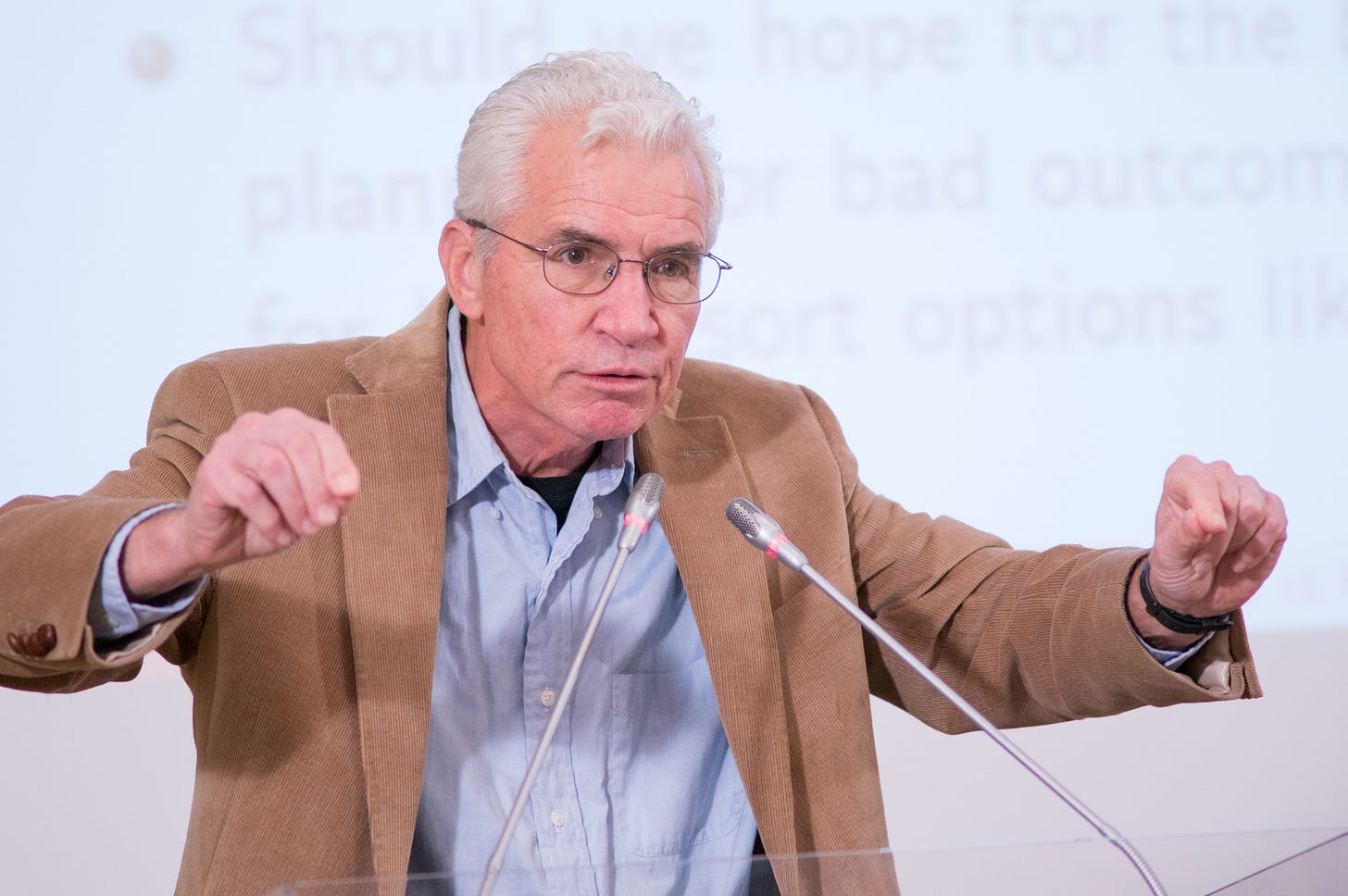A trickle of transcripts!
First up, an administrative note: many, many people have requested written transcripts of the Volts podcasts. And I want to provide them. But it’s going to take a while.
I could produce the transcripts in a few hours if I were willing to simply send the sound files through a robot transcriber like Otter and accept the somewhat choppy results (which are generally around 85 percent accurate).
However, I’m way too anal retentive to do that. And Volts readers deserve better! I want to clean the transcripts up — remove all the “sort of’s” and “kind of’s,” delete aborted or repeated sentences, polish up the grammar — so that they are as pleasant to read as they are to hear. (I’m not that precious about preserving the exact original words; I’m more interested in clearly capturing meaning in readable form.)
That means closely copyediting these files, some of which are more than 10,000 words. So far, with a little help, I’ve gotten through … one. And it took about 10 people-hours of work. Sigh.
Here’s the full transcript of my podcast with Rep. Sean Casten on “Hot FERC Summer” (and here’s a PDF version). For those who’d like a more compact version, here’s a highlight reel running on Canary.
Hopefully these will get somewhat faster and easier going forward. I will let you know as they come out. Now, on to the main event.
Pulling tipping points into climate economics
Just about everyone familiar with climate change has heard about “tipping points.” Famed climate scientist Wallace Broecker first raised the possibility way back in 1987, and ever since then, they’ve loomed large in the climate discussion.
The idea behind tipping points is fairly simple and familiar: as heat accumulates in the atmosphere, Earth’s geophysical systems may not simply adjust in linear fashion, alongside the incrementally rising temperature; in some cases, they may “tip over” some unpredictable threshold and enter a fundamentally new state, sometimes called a “phase shift.” Think of ice that has slowly cracked suddenly shattering, or “the straw that broke the camel’s back.”
The commonly cited examples of potential tipping points are the Greenland and West Antarctic ice sheets. As warming has progressed, they have been shedding water and developing deep fissures. It is possible that at some (unpredictable) point, one or both will lose integrity and begin breaking apart altogether, irreversibly, raising global sea level dozens of feet in relatively short order.
Because the consequences of some oft-discussed tipping points are rather apocalyptic, they have been used and misused for a long time in climate communications. It has somewhat annoyed climate scientists, because not only are these tipping points not a sure thing, each one is, in its own right, relatively unlikely.
Civilization-ending changes are not likely, but they’re not zero probability either. Legendary Harvard economist Martin Weitzman called these low-probability, high-impact possibilities “tail risks” and was famous for warning that economists are not taking them into account — and are thus underestimating the need for rapid decarbonization.
In his book Climate Shock, co-authored with his protégé, New York University’s Gernot Wagner, he argued that the right way to think about climate mitigation is not through a cost-benefit lens, as though particular levels of spending avoid specific levels of damages, but instead as a kind of insurance. We purchase insurance to cover against tail risks all the time, not because we think they’re likely to happen, but because the consequences would be so dire if they did.
Weitzman has passed away, but Wagner and others have carried on this argument long enough that it has begun to break through in mainstream climate economics. However, it leaves a key question unanswered: yes, the risk of tipping points raises the value of mitigation, but how much? It has never been quantified.
Into that breach comes a new paper in the Proceedings of the National Academy of Sciences (PNAS), from Wagner and a group of colleagues: Simon Dietz and Thomas Stoerk of the Grantham Research Institute on Climate Change, and James Rising of the University of Delaware.
“Economic impacts of tipping points in the climate system” represents the first formal attempt to quantify the economic impacts of tipping point risks. The results are startling: the economic impact of carbon emissions is much higher than appreciated, as is the value of reducing emissions.
Not that we needed much more evidence, but this study makes it clear that there is virtually no way we could overdo it on decarbonization. As Wagner told me when I called him to discuss the results, “I don't see a downside to doing too much too quickly.”
The devilishly difficult task of quantifying risks
The PNAS authors adopt a common definition of tipping points: “subsystems of the Earth system that are at least subcontinental in scale and can be switched—under certain circumstances—into a qualitatively different state by small perturbations.”
They included the eight that have been studied by the IPCC:
Thawing of permafrost leading to carbon feedback resulting in additional carbon dioxide and methane emissions, which flow back into the carbon dioxide and methane cycles.
Dissociation of ocean methane hydrates resulting in additional methane emissions, which flow back into the methane cycle.
Arctic sea ice loss (also known as “the surface albedo feedback”) resulting in changes in radiative forcing, which directly affects warming.
Dieback of the Amazon rainforest releasing carbon dioxide, which flows back into the carbon dioxide cycle.
Disintegration of the Greenland Ice Sheet increasing sea-level rise.
Disintegration of the West Antarctic Ice Sheet increasing sea-level rise.
Slowdown of the Atlantic Meridional Overturning Circulation modulating the relationship between global mean surface temperature and national mean surface temperature.
Variability of the Indian summer monsoon directly affecting GDP per capita in India.
It’s important to note that these are not all possible tipping points, just the ones that have been studied, so the PNAS study’s results are, as the authors emphasize, a “probable underestimate, given the literature we synthesize has yet to cover some tipping points and misses possible impact channels and interactions even for those it does cover.”
In their survey of existing literature, the authors found 52 papers that quantified the economic impacts of one or more tipping points, but over half of those were based, not on geophysical data or analysis, but on highly stylized adjustments to model parameters. The authors put those aside. In the end, they focused on 21 papers that actually linked the geophysical mechanisms of tipping points to economic damages.
The whizbang procedural move of the paper is to pull these different studies — many using different models with different assumptions — into a single “meta-model,” with replicas of each studied tipping point combined in a single framework. (There is a great deal of discussion of this methodology in the paper, and more in an extended appendix, if you’re interested.)
The result is an ability to directly compare, and to sum up, the possible economic damages of tipping points. From there, applying a few conventional assumptions about discount rates and risk aversion, a model can spit out a number for the present-day costs of those future risks.
Obviously, any estimate like this going to be somewhat faux-precise, involving all kinds of assumptions and probability ranges piled atop one another, so it must be taken as provisional and tentative, subject to further research. But still, it’s better than having no estimate at all.
We are underestimating climate risks and overestimating the costs of action
As its principal metric, the study uses the “social cost of carbon” (SCC), meant to capture the total social and environmental damage done by the emission of a ton of carbon dioxide.
For convenience, it uses the current US government SCC figure, which is about $51. There’s a history behind this: Obama originally convened the working group that put the figure at around $50 during his administration. Under Trump, it dropped to about $1. Biden has bumped it back up to $51.
“They undid the Trump damage and went back to decade-old assumptions,” says Wagner. Now, there is work underway to update the US government SCC with better numbers. “If you go to the most modern estimates and turn on the stuff that we think ought to be turned on — we know that there are tipping points, we need risk aversion, we need reasonable discount rates, and so on — you don't get to $50,” he says, “you get $250.” (For the true climate modeling nerds: that’s true even in DICE, William Nordhaus’s model.)
I don’t know if the new number will be $250, but I’d be shocked if it were under $150. Anyway, that’s a subject for another post, because the PNAS study quantifies the relative increase in SCC when tipping points are incorporated rather than ignored.
The headline result: “When modelled separately and then summed together, the individual tipping points increase the expected SCC by 24.5%.”
The details:
As you can see, the most costly tipping points are the release of ocean methane hydrates and permafrost carbon. A couple, like the Atlantic Meridional Overturning Circulation, average out to reduce the SCC. (A change in the AMOC might shelter some parts of Europe from the worst effects of climate for a while — though this effect might be overwhelmed as the damages are better understood.)
The main thing to note is that 25 percent is not a small number. If we’re systematically underestimating the cost of carbon emissions by a quarter, we’re probably giving bad policy advice — badly underplaying the urgency of action.
But another important note is that 25 percent is the median estimate of the effect of tipping points on SCC. Just as with estimates of the physical damages of climate change, estimates of the economic costs of tipping points have a long right tail.
These are the tail risks Weitzman warned about, translated into economic terms. SCC could be higher if climate sensitivity is higher than estimated, if people are more risk averse, if discount rates are lower, if tipping points arrive sooner, or any number of other variables go the wrong way.
What it means is, there’s a small-but-not-negligible chance that we are currently underestimating the cost of carbon emissions by as much as 250 percent or more. (Look at that “More” blob!) If that is true, we’re really giving bad policy advice, as in, “market mechanisms” vs. “wartime footing.”
The policy implications of tipping points
Let’s take a step back and review what we can learn from this study.
First, economists have more or less been ignoring tipping points, which means they have systematically been underestimating the SCC. Best estimates put the amount of that underestimation around 25 percent.
But that 25 percent is almost certainly a lower bound. The authors have built a framework that can plug in new data and analysis of tipping points as it comes along. It is almost certain that as more tipping points are studied and the interactions among them are better modeled, the estimate of their potential damages will rise.
And again, remember that long tail. 25 percent is the median estimate, but the average estimate is 43 percent, and there’s at least a 10 percent chance of 100 percent — in other words, “there's a one in 10 chance that doing the calculation doubles the SCC,” says Wagner. “Holy shit, right?”
“So if you start with $150,” he says, “there's a 10 percent chance you'll end up with $300, just because of tipping points.”
One in ten is not that small a chance. If the chances of a plane going down were one in ten, you probably wouldn’t board it. It probably wouldn’t be allowed to fly.
This is the significance of tipping points: we are playing with fire, pushing Earth systems to the point that there is a small-but-real chance that some of them will break down entirely, entering phase shifts and becoming something permanently less stable and hospitable.
If that happens, we will have consigned all future generations of human beings to inexorably and irreversibly deteriorating conditions. It is a crime worse than any genocide, worse than any atrocity conceived or conceivable, and even if there is only a small chance that we might stumble into committing it, we should be hyper-cautious. We should spend a lot of money to reduce that risk, to insure against it.
You might notice that we are not, as a global community or within the US, expending $50/ton worth of effort to reduce emissions, much less $300/ton. In that sense, this study is just one more voice in the chorus urging policymakers to go bigger and faster on decarbonization.
But it does put a fine point on the fact that there is effectively no way for policymakers anywhere to do too much, or to go too fast, on decarbonization. The risk of overdoing it is vanishingly small, all but impossible.
We are currently underdoing it. We will be underdoing it even when we’re doing five times what we’re doing now. We will almost certainly be underdoing it for the rest of the lives of everyone reading this. That’s daunting, but it’s also clarifying.
There’s only one direction to push: more and faster, forever and ever, amen.






















Share this post